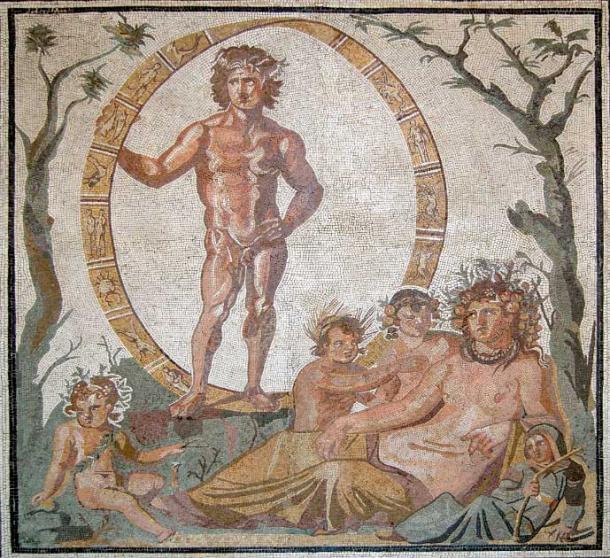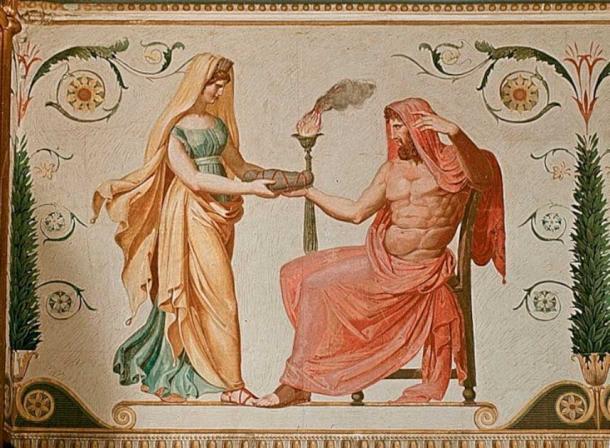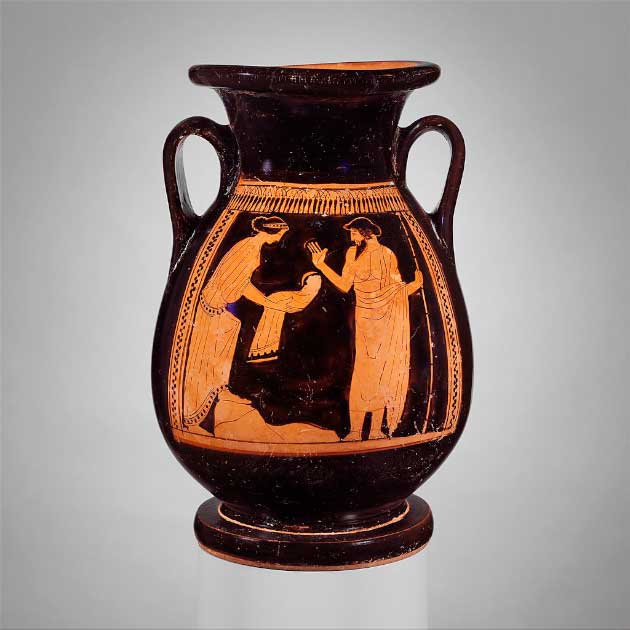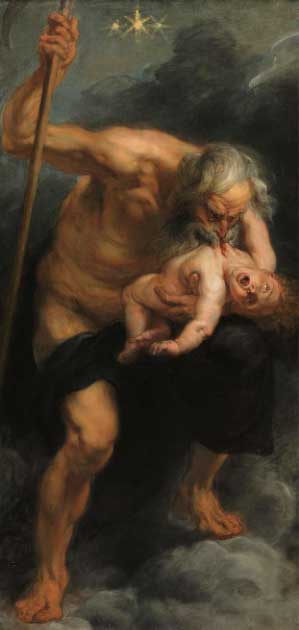
Cronus: The Titan Harvest God and Erroneously The Titan Time God
Cronus, the Titan of Time is often depicted today as Father Time. However, the original Greek myth has few, if any, actual links between Cronus and time. Whilst he is never named in the records of these myths as “Father Time,” some have seen his actions as metaphorical for how time works. For example, by swallowing his infant children, he consumed many years, or, through his destructive actions, he was symbolic of how time destroys all things. Despite the confusion and the arguments over his links to time, the myth of Cronus still presents an eventful and exciting story.
Cronus the Titan of Time
The confusing link between Cronus and time can be traced all the way back to antiquity. It is thought that during this time, Cronus was on occasion confused with the personification who was named Chronos.
This confusion was perpetuated by the Roman philosopher Cicero who argued that the name Cronus was equivalent to the word “ chronos” which means time. He consolidated this argument by using as evidence the part of the myth where Cronus swallows his children to prove that Cronus owned and had power over many years.
- Gaia: Recognizing Our Role on a Living Earth
- Passing Through the Gates of Time: The Mind, Time Travel, and St Augustine
Many others have interpreted Cronus’ link to time in this way, seeing Cronus’ actions as metaphorical for the way time destroys all things eventually. In this sense, by devouring his sons, the past was consuming the future as father consumes son.
In the 5th century the Neoplatonist philosopher Proclus produced his Commentary on Plato’s Cratylus. In this work Proclus also provides an explanation for the link between Cronus and time. Among other arguments, he states that “One cause” of all things is “Chronos” (time) which he states is the same as Cronus.
During the Renaissance Cronus’ link to time was further solidified. The link between Cronus and Chronos gave rise to the nickname “Father Time.”

Cronus, holding his sword and child, as depicted in this famous statue by Georg a Paul Heermann in Prague, Czech Republic. (Renáta Sedmáková / Adobe Stock)
The Myth of Cronus
The most popular source for the myth of Cronus is the Theogony, written by the Greek poet Hesiod. The tale of Cronus’ life begins with a feud between his mother, Gaia, the personification of Mother Earth, and his father Uranus, the personification of the sea and the supposed creator of the universe.
Gaia was mother not only to Cronus but to his brothers and sisters, the (other) Titans. She was also mother to the great Hecatoncheires (who was said to have a hundred hands) and several Cyclopes (famous for their single eye).
The feud between Cronus’ parents began when Uranus decided to hide the Hecatoncheires and the Cyclopes from Gaia. Uranus abandoned his offspring in Tartarus a place said to be especially reserved for punishment as it was the deepest region of the world, effectively Hell. It seems that Uranus was disgusted by the monstrous appearance of his children and wanted to be rid of the sight of them.
Understandably, Gaia was not pleased to discover that her children had been abandoned in such a place and began to plot her revenge. She began by forging a great stone sickle blade from the earth.
She then sought out her remaining children (the Titans) and said to them:
“My children, gotten of a sinful father, if you will obey me, we should punish the vile outrage of your father; for he first thought of doing shameful things.” (Theogony, 163)
To this, none of them replied for they were all too scared to stand up to their ruthless father. However, Cronus came forth and answered:
“Mother, I will undertake to do this deed, for I reverence not our father of evil name, for he first thought of doing shameful things.” (Theogony, 167)
Gaia then gave her sickle to her son and revealed her awful plan of revenge.
That night, when Gaia went to bed, Cronus hid in her room. When his father, Uranus, came to lie with Gaia, Cronus ambushed him wielding his sickle. Cronus then proceeded to castrate his own father and tossed his testicles into the sea.

A 3rd-century AD mosaic of Aion-Uranus with Terra (Greek Gaia) from a Roman villa in Sentinum (Sassoferrato, Italy). Aion-Uranus, the god of eternity, is standing inside a celestial sphere decorated with zodiac signs. Sitting in front of him is the mother-earth goddess, Tellus-Gaia with her three children: Uranus (the Sky), Ourea (the Mountains), and Pontus (the Sea) . (Glyptothek / Public domain)
Ironically, because of his hatred for his children the Hectoncheires and the Cyclopes, from Uranus’ spilt blood grew three more monstrous children. The Gigantes, Erinyes and the Meliae all formed from his blood which had pooled on the earth.
From his testicles, which were lost to the sea, white foam was created and from this grew the goddess Aphrodite.
What happened to Uranus after his castration is unclear. It appears he either died, left Earth or exiled himself to Italy. Cronus and his sister, Rhea, married and ruled in his place. The couple had multiple children (who were also gods). Their offspring included Demeter, Hestia, Hera, Hades, and Poseidon.
It was said that whilst Cronus ruled the Universe in his father's place there was a “Golden Age” during which laws were not needed and life prospered. But this peace did not last for long. Cronus eventually learned from his mother that he “ was destined to be overcome by his own son.” (Theogony, 453)
Cronus was terrified by the thought of being overcome by one of his children. His rather illogical solution was to swallow each of his children to prevent them from being able to do so. Understandably, Rhea was not happy with this.

In this 19th-century painting by Karl Friedrich Schinkel, Cronus’ sister Rhea gives him the stone wrapped in swaddling clothes that he believes to be Zeus, his son. (Karl Friedrich Schinkel / Public domain)
Alongside her mother-in-law Gaia, Rhea sought to prevent her next son, Zeus, from meeting the same fate. There are differing accounts of how she did this, however, the Theogony records that Rhea travelled to Crete where she gave birth to Zeus. Here, Gaia remained to care for her infant grandchild who she hid in a remote cave on Mount Ageum.
To distract Cronus, Rhea then gave him a large stone wrapped in a baby’s blanket which he swallowed believing it was one of his children. Cronus then continued to live his life believing he was safe from his children, whilst unbeknownst to him, his son Zeus was growing up and harboring increasing resentment towards his father.
Some sources of the myth say that Zeus returned disguised as his father’s cupbearer and snuck him an emetic (to cause vomiting) in his wine. This caused Cronus to vomit up the stone, followed by his children. The theogony, however, records that he was “ beguiled by the deep suggestions of Earth [Gaia]” and brought his offspring back up himself.
Zeus then placed the stone at Pytho, under the glens of Parnassus. It was intended to be a sign to mortal men. He then set free the sons of Heaven who his father had previously imprisoned. As a reward for doing so they gave him “ thunder and the glowing thunderbolt and lightening: for before that, huge Earth had hidden these.”

In this painting of the Titanomachy by Cornelis van Haarlem, Zeus and his allies fight against Cronus and the other Titans, which ends in Cronus’ side losing. (Cornelis van Haarlem / Public domain)
The Titanomachy
After he had saved his siblings from his father’s stomach, Zeus set about releasing the re-imprisoned Hectaoncheires and the Cyclopes (yes Cronus eventually re-imprisoned his siblings after so much effort to save them!). He then recruited all his siblings in an effort to overthrow their father.
What followed was a war between Zeus and Cronus (and the Titans) known as the Titanomachy. Zeus and his siblings eventually managed to overwhelm and overthrown their father Cronus. They took the Titans and:
“Buried them beneath the wide-pathed earth, and bound them in bitter chains when they had conquered them by their strength for all their great spirit, as far beneath the earth to Tartarus.” (Theogony, 713)
What happened to Cronus after the war is unclear. Some sources, including the Homeric texts, state that he was imprisoned with the Titans in Tartarus. He is imprisoned in the Cave of Nyx according to Orphic poems, and, according to Pindar, Cronus eventually makes it out of Tartarus and is made King of Elysium by Zeus.
Some accounts go as far as to state that Cronus returned to his good, old ways. He was promoted to ruler of the Islands of the Blessed, which was said to be a heavenly resting place for the souls of earthly heroes.
- Aphrodite: The True Origins of the Greek Goddess of Love, Sex, and Beauty
- Centaurs in Greek Mythology: From the Iliad to Sagittarius and Harry Potter

Another depiction of Rhea giving Cronus the stone wrapped in cloth in place of their son Zeus. Terracotta pelike (jar), circa 460–450 BC, attributed to the so-called Nausicaä Painter, part of the Metropolitan Museum of Art's collection in New York. (Metropolitan Museum of Art / CC0)
The Cronus Myth According to Other Sources
In Diodurus Siculus’ (Greek historian, 1st century BC) version of the myth, Cronus’ mother was not Gaia, but a woman named Titaea. In this telling, Cronus does not only declare war on the Titans and his father, but also his brother Jupiter who was ruler of Crete.
Furthermore, Cronus is not his sister’s first husband in this telling. Originally Rhea married a man named Ammon, King of Libya. However, Ammon cheated on his new wife and lay with a woman named Amaltheia who became pregnant. Ammon raised his illegitimate son in secret, fearing the fury of Rhea.
Eventually, Rhea learned of Ammon’s behavior and forsook her husband and ran off to her brother, Cronus. Upon hearing what his sister had endured, Cronus declared war on Ammon which, with the aid of the Titans, he won.
Cronus then placed himself on Ammon’s throne where he was said to be an extremely harsh king. Nevertheless, he was eventually overthrown by Ammon’s son Dionysus. Because of his kinship to the pair, Dionysus was lenient on them.
Dionysus set Zeus up as the King of Egypt and placed at his side Olympus. The two sons then joined forces and defeated the Titans that remained on Crete. Then, upon his death, Dionysus left his lands to Zeus who would later become the Lord of the World.
Another source than mentions Cronus is the Sibylline Oracles. According to book three, Cronus had two other brothers named Titan and Iapetus. It agrees with the Theogony that their parents were Uranus and Gaia. The Earth was divided between the three brothers and Cronus was made king of it all.
As in the other two versions of the myth, Cronus and Rhea began a romantic relationship and ended up producing children. However, rather than Cronus being the cause of his children’s demise, in this version, his brother Titan attempts to eliminate his siblings’ offspring as soon as they are born.
When Rhea’s next son, Zeus, is born, she takes the infant with her to Dodona in northwestern Greece to save him from his uncle. She then later sent Zeus, along with his brothers Poseidon and Hades, to Phrygia, where they were cared for by three Cretans.
Eventually, Titan learned that his sister had been hiding her offspring from him and ordered an army of 60 men to imprison Cronus and Rhea. In response to this, Cronus and Rhea’s children declared war against Titan and his men.

This painting by Peter Paul Rubens illustrates the story of Cronus eating his children to steal their time as Father Time. (Peter Paul Rubens / Public domain)
Cronus’ Legacy
Cronus is still celebrated today, particularly because of his links to agriculture as the Titan of the Harvest. In art, he is often depicted as an old man with an impressive beard holding a farming instrument, usually his sickle, and sometimes a harp or a curved sword. When he is depicted in his youth he often appears as a tall, powerful man.
The tale remains an interesting and gripping story. It provides an example of a son standing against his father only to become what he despised in his father by attacking his own children. In this way, the tale is powerfully ironic.
Top image: The mythological painting Cronus and his child by Giovanni Francesco Romanelli, which in some myths has Cronus eating his children to take their "time,” because he somehow ended up as the “model” for Father Time. Source: Giovanni Francesco Romanelli / Public domain
By Molly Dowdeswell
References
Britannica. n.d. C ronus. Available at: https://www.britannica.com/topic/Cronus
Greek Mythology. n.d. Cronus: The Titan Leader. Available at: https://www.greekmythology.com/Titans/Cronus/cronus.html
Homer and Hesiod. 2008. Hesiod, The Homeric Hymns and Homerica. Available at: https://www.gutenberg.org/files/348/348-h/348-h.htm
Oldfather, Charles Henry. 1939. Diodorus Siculus: The Library of History. Available at: https://penelope.uchicago.edu/Thayer/E/Roman/Texts/Diodorus_Siculus/3E*.html
Regula, DeTraci. 2019. Kronus. Available at: https://www.thoughtco.com/detraci-regula-5190034
Sacred Texts. 1899. The Sibylline Oracles. Available at: https://www.sacred-texts.com/cla/sib/sib.pdf
















Comments
Maybe all these odd God stories were the earlier form of e.g., Aesop’s Fables, i.e., told to impart important lessons to the children and otherwise naive?
But as relates, you have to acknowledge the planetary associations and wonder if or how Uranus, Saturn and Jupiter have influenced life on Earth from the very beginnings of aboriginal (prehistoric) humanity. ...Also noting that stone-age Earth was rendered ruins, probably via same event that caused the sudden emergence of the Ice Age, circa 120k years ago, and that Mars may have been similarly assaulted and didn’t survive it as well.
Nobody gets paid to tell the truth.